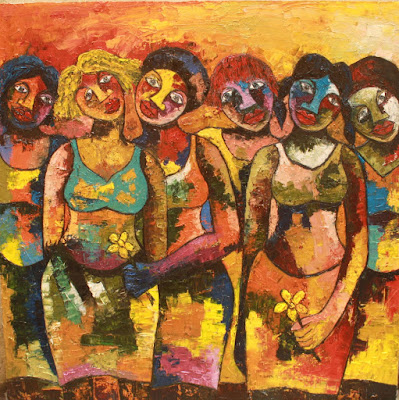By Tajudeen Sowole
 |
Sidiquat from Polly Alakija’s Art With A Social Conscience
|
For over
a year, Alakija who shares her studio base between Lagos and Gloucestershire,
U.K. has been using art to engage communities in select Nigerian urban and
rural spots. Some of the works, produced from her Artist-in-Residence form the
bulk of the display.
Mounted at the reception of the lounge are
portraits of Nafisa and Tilatu
painted during Alakija's residence at Fifth Chukker Polo Club, Kaduna as well
as drawings from her Lagos Jazz Series such as Africa 80 in Rehearsal: Kalakuta,
Keyboard Player, Tony Allen, among others.
Stepping inside the lounge proper, the
canvas begins to open up, displaying elaborate works of an artist whose realism
style of painting perches on outline of figures to emboss images off the
canvas.
One of
the revelations from Alakija's Art With A
Social Conscience exhibition is the hidden fact that Lagos has been an alternative
or temporary homes to quite a number of IDPs from the northeast of Nigeria.
Three paintings Two Boys Series I and
II as well as Gambo and Family explain quiet rehabilitation of Boko Haram-related
victims and IDPs in Lagos. The two paintings of an adult and a young - roughly
under seven years old - stress the diverse textures of the IDPs in Lagos. As at
the period of the painting, the only help, which the senior of the boys could
offer his younger brother was a rest to take sleep on his laps. The IDPs found
their ways to Ikoyi with the hope that "there would be a better
opportunity in Lagos," Alakija says.
For
Gambo, a family man who strayed into the canvas of Alakija - as Keke NAPEP driver - during the artist’s
community art project, Lagos is not his kind of place. Gambo, Alakija
discloses, is from Chibok, and got married in Lagos after his partner was sent
to him from another part of the north. "He is not happy in Lagos, wants to
go back to Chibok as soon as possible," the artist narrates her experience
working with Gambo who, in addition to using his keke for the project, also "assists in some painting works
with the participant children during workshop."
Alakija's canvas is populated with stories
that could inspire a bestseller. Sidiquat,
painting of a mother and child, according to the artist is a narrative of
another home-sick parent who, though had her baby in Lagos, "now wants to
go back to the north east."
Between
the depth of the artist's skills on canvas and her choice of subject, the
attention appears to be more on the latter. And not exactly a commendable one
for the artist, so some observers feel. She recalls being asked: 'Polly, these
are sad paintings. Can't you tell other stories?' But she argues that these are
the realities she "encounters."
However,
Alakija's canvas is not all about 'sad' stories, so suggest other works such as
She Didn't Come To Lagos To Count Bridge,
Ayoba and murals on a ferry, among
others that either focus on the colourful side of the aquatic city or narrative
from legendary world of Susanne Wenger’s Osogbo.
More importantly, the Art With A Social Conscience exhibition, which was organised in
partnership with The Children’s Developmental
Centre (CDC) as a community project, also helps to support NGOs that are
involved in rehabilitation of IDPs and other related victims of socio-economic
imbalance. Proceeds from the sales of the paintings, Alakija assures go to volunteer
groups. Among such is ETN Church, Ikeja.
Commending
the effort of Alakija, one Africa's top art collectors Prince Yemisi Shyllon
who was a guest speaker at the opening stated: "The kind of exemplary
contributions to society by Alakija are what makes life meaningful.”









